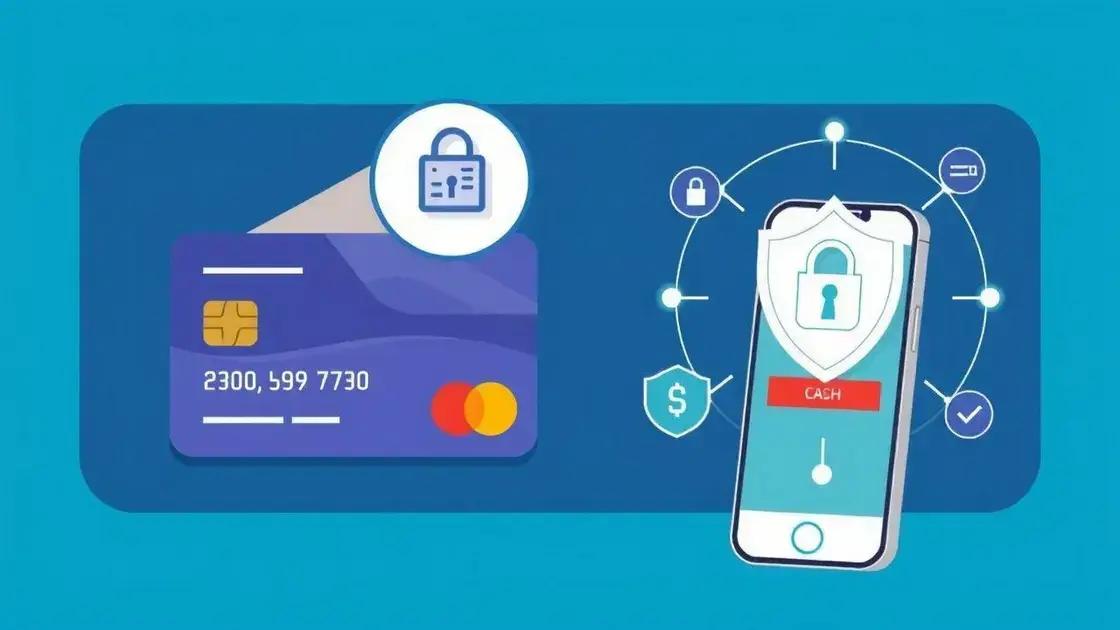Latest updates on credit card and digital wallet integration

Anúncios
Choosing the right payment method involves evaluating factors such as cost, security, and customer preferences, while staying informed about emerging technologies like digital wallets and cryptocurrencies for better overall satisfaction.
Latest updates on credit card and digital wallet integration are changing the way we handle our finances. Curious about how these innovations can simplify your life? Let’s explore the impact of these developments.
Anúncios
Overview of credit card integration
Overview of credit card integration is essential to understand how payment processing works today. With the increasing reliance on technology for transactions, it’s crucial to grasp what credit card integration entails.
The process of integrating credit cards involves linking the card’s payment system with an online platform. This simplifies buying and selling by allowing businesses to accept payments directly through their websites or applications.
Anúncios
Benefits of Credit Card Integration
There are several notable advantages to integrating credit cards into a payment system. This allows for quick transactions, improved customer experience, and increased sales opportunities.
- Faster transactions mean customers spend less time at checkout.
- Enhanced customer experience leads to higher satisfaction and repeat business.
- Increased sales opportunities can arise from offering multiple payment options.
- Improved security features protect sensitive information.
Furthermore, credit card integration streamlines inventory management, as sales data is automatically recorded. Plus, it contributes to better financial tracking, giving businesses real-time insight into their revenue.
Security Features
As with any financial transaction, security is paramount. Integrated credit card systems come equipped with various security measures, minimizing the risk of fraud. These may include encryption protocols, compliance with PCI standards, and tokenization.
Investing in a reliable integration solution not only safeguards your business but also builds trust with customers. This trust can significantly impact your brand’s reputation.
In conclusion, understanding credit card integration is vital for modern businesses. It enables efficient payment processing while providing customers with a seamless shopping experience.
Benefits of digital wallet usage
Using a digital wallet has become increasingly popular among consumers and businesses alike. This innovative payment method offers several advantages that can significantly enhance the shopping experience.
One of the primary benefits of digital wallets is their convenience. With a digital wallet, users can store multiple payment methods in one place, making transactions quick and easy. Instead of fumbling for cards or cash, a simple tap on a smartphone or smartwatch can complete purchases.
Security Features
Another essential aspect of digital wallets is the enhanced security they provide. Most digital wallets use encryption and advanced security measures to protect users’ personal information. This makes them much safer compared to traditional wallets filled with cash and cards.
- Data encryption safeguards sensitive information.
- Two-factor authentication adds another layer of security.
- Fraud monitoring alerts users of suspicious activity.
- Tokenization protects card details without storing them.
In addition, digital wallets can help users manage their finances better. Many digital wallets come with budgeting tools, allowing users to track spending habits and set savings goals. This feature is particularly useful for anyone looking to improve their financial literacy.
Speed and Efficiency
Not only do digital wallets offer security, but they also save time. Transactions are typically processed faster than traditional credit or debit card methods. Users can quickly pay at checkout without needing to input card information each time.
As digital payments continue to grow, the use of digital wallets will likely expand as well. More businesses are beginning to accept this payment method, providing customers with even greater flexibility. Adopting a digital wallet can lead to a more streamlined shopping experience, saving both time and effort.
Security concerns with credit cards and wallets

When it comes to using credit cards and digital wallets, security concerns are at the forefront of many users’ minds. Both methods of payment come with inherent risks that must be understood to protect personal information.
Credit cards, while convenient, can expose users to fraud if not handled carefully. Phishing attacks and data breaches can compromise sensitive account details. This makes it essential for users to be aware of these threats and take necessary precautions.
Common Security Risks
Understanding the common security risks associated with credit cards and wallets can help users stay vigilant.
- Card cloning: Thieves can clone credit cards using skimmers at ATMs or gas stations.
- Online fraud: Fake websites may trick users into entering sensitive information.
- Data breaches: Large retailers may suffer data breaches where personal information is stolen.
- Lost or stolen cards: Quickly report lost cards to avoid unauthorized charges.
Digital wallets also come with their own set of concerns. While they use encryption and tokenization to protect transactions, users must remain cautious. If someone gains access to their mobile device, they may be able to circumvent security measures.
Protecting Your Information
To protect sensitive information, users should adopt several best practices. Always use strong, unique passwords and enable two-factor authentication when available. Keeping software updated ensures vulnerabilities are patched, reducing the risk of unauthorized access.
Additionally, regularly monitoring bank statements helps catch unauthorized transactions early, providing a chance to report them promptly. Users should also consider setting up alerts through their bank or wallet provider for added security.
In a world where digital payments are becoming the norm, being informed about security concerns helps users make safer choices. By understanding these risks and implementing protective measures, they can enjoy the conveniences of technology without compromising their privacy.
Future trends in payment technology
The future trends in payment technology are shaping the way consumers and businesses interact financially. As technology evolves, so does the landscape of payment options available, making transactions faster, easier, and more secure.
One of the most significant trends is the rise of contactless payments. With the introduction of NFC (Near Field Communication) technology, users can pay with just a tap of their cards or smartphones. This form of payment is gaining traction due to its speed and convenience.
Growth of Mobile Payments
Mobile payments are also on the rise, fueled by the popularity of smartphones. Applications that allow users to store credit card information securely have made it easy for consumers to make purchases without needing physical cards. Peer-to-peer payment systems, such as Venmo and Cash App, are becoming increasingly mainstream.
- Increased smartphone usage: More people are using smartphones, making mobile payments more accessible.
- Integration with e-commerce: Many online stores now offer one-click payments for mobile users.
- Frictionless experiences: Users can complete purchases quickly without navigating complex payment processes.
Another essential trend is the growth of cryptocurrency and blockchain technology. Many businesses are starting to accept cryptocurrencies as payment, and this method provides a new level of security and transparency. The decentralization of transactions can offer significant advantages, especially in cross-border payments.
Artificial Intelligence in Payments
Artificial intelligence is also transforming the payments landscape. AI algorithms help detect fraudulent activities by analyzing spending patterns and alerting users in real-time. Chatbots and virtual assistants are streamlining customer service in payment processing, providing quick responses to inquiries.
Furthermore, the focus on security and privacy continues to drive innovations in payment technology. As data breaches become more common, solutions that prioritize consumer protection will lead future advancements. Biometric authentication, such as fingerprint and facial recognition, is becoming a standard for securing payment methods.
How to choose the right payment method
Choosing the right payment method is crucial for both consumers and businesses. The right option can enhance convenience, boost sales, and ensure security. Understanding the various payment methods available is the first step in making informed choices.
When considering payment methods, one should evaluate their specific needs. Factors such as transaction fees, user experience, and security features play significant roles. For businesses, integrating systems that provide multiple payment options can greatly improve customer satisfaction.
Key Factors to Consider
Several important factors will help guide the decision on which payment method to choose.
- Cost: Look for transaction fees or subscription costs associated with each payment option.
- Ease of use: The process should be straightforward for both customers and merchants.
- Security: Ensure that the option complies with security standards to protect sensitive information.
- Flexibility: Consider whether the method supports various currencies and payment types, accommodating a wider audience.
Evaluating customer preferences is also essential. Many consumers prefer mobile payments or digital wallets for their convenience. Businesses should analyze their target market to determine what methods are likely to be accepted and preferred.
Testing and Feedback
After selecting a payment method, it is essential to gather feedback from customers. Their experiences will provide valuable insights into the efficiency and satisfaction levels of the chosen system. Monitoring transaction success rates and addressing any concerns promptly can lead to improved processes.
Finally, it’s important to stay updated on trends in the payment technology space. New options and innovations emerge regularly, and adapting early can provide a competitive advantage. By carefully evaluating factors and incorporating customer feedback, businesses and consumers can confidently choose the right payment methods.
In conclusion, understanding the various aspects of payment methods is essential for consumers and businesses alike. By evaluating factors such as cost, security, and user preference, individuals can make informed choices. Embracing new technologies like digital wallets and cryptocurrencies can provide greater flexibility and convenience. Staying updated with emerging trends will also help ensure that the chosen payment methods remain relevant and secure. Overall, making informed decisions about payment options leads to a better shopping experience and enhances overall satisfaction.
FAQ – Frequently Asked Questions about Payment Methods
What are the most secure payment methods available?
The most secure payment methods include digital wallets with encryption, contactless payments, and credit cards that offer fraud protection.
How can I ensure a smooth payment experience for customers?
To ensure a smooth payment experience, offer multiple payment options, keep the checkout process simple, and regularly update your payment systems.
What factors should I consider when choosing a payment method for my business?
Consider transaction fees, user preferences, security measures, and the technology’s compatibility with your existing systems.
How can I analyze customer preferences regarding payment methods?
You can analyze customer preferences through surveys, monitoring transaction data, and gathering feedback during the checkout process.






